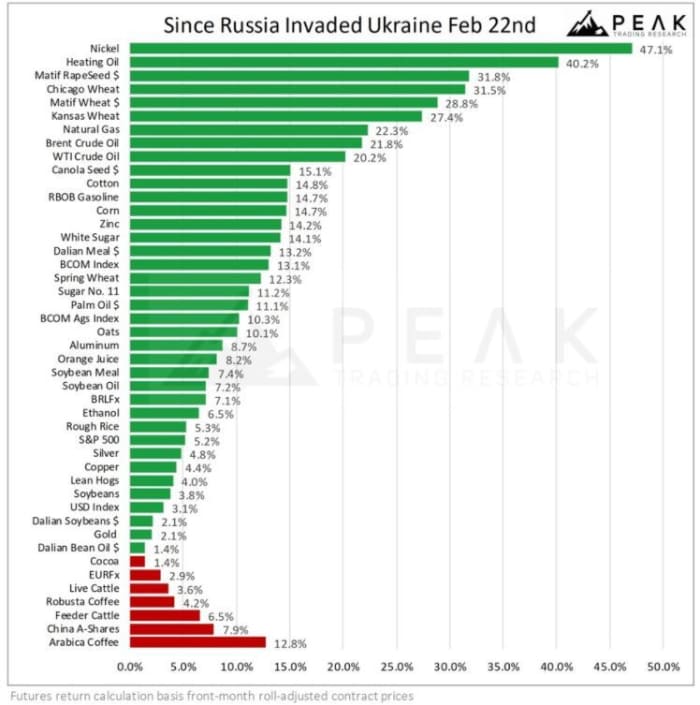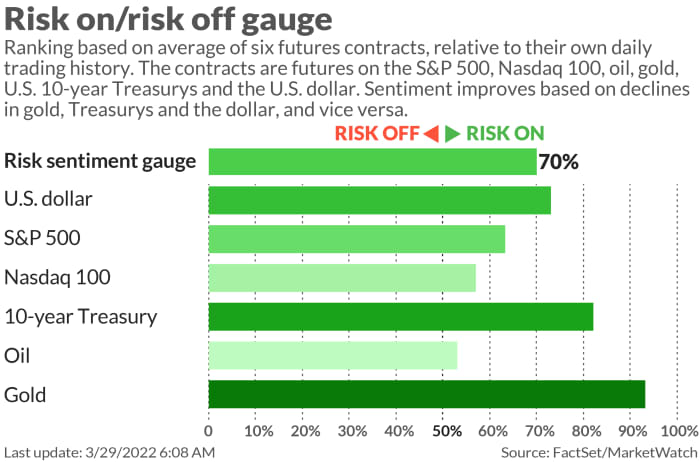This post was originally published on this site
Stock futures are rising, as optimism is in the air over a potential breakthrough for negotiations between Ukraine and Russia on Tuesday.
Obviously not just markets would welcome a halt in the humanitarian disaster. Apart from that obvious point, other worries have focused on disruptions to farming in the global breadbasket of Ukraine.

“The #1 improvement this week: Ukrainian forces are successfully defending Kyiv and there’s more optimism that Russia will focus efforts only on the Donbas region,” noted David Whitcomb, head of research at Peak Trading Research, a Geneva-based quantitative commodity trading and research group. “That means farmers could be able to get more crops in the ground with confidence over the coming weeks. We’ll see…”
That brings us to our call of the day, from Chris Rawley, CEO of Harvest Returns, a crowdfunding real estate platform that focuses on farmland. He recently spoke to MarketWatch about potentially overlooked agriculture investments.
While farm-based exchange traded funds, and grain futures are all options, Rawley views those as “more of a speculative product. Also these commodity trades are used by farmers and ag businesses as a hedge instrument,” he said.
Opinion: High fertilizer prices are creating pain for consumers and gains for investors
His sweet spot is farmland, though on its face is not cheap or easy for the average investor, said Rawley. Some of the world’s biggest billionaires are landowners, such as media mogul Ted Turner who owns 2 million acres, Amazon.com’s
AMZN,
CEO Jeff Bezos who has amassed 420,000 acres and Microsoft
MSFT,
co-founder Bill Gates’s 270,000 acres, he notes.
One way in is through is farmland REITS, such as Gladstone Land
LAND,
or Farmland Partners
FPI,
up 100% and 20% over the past year. He points to another option that he also sees as accessible — farm, farmland and agricultural investments via private placements, which is in the wheelhouse of Harvest Returns.
How it works? Buying a 1,000 acre farm and its crops would take hefty capital that the average investor can’t manage. “If you put a bunch of those investors together, you’re able to pool those investments and go in and buy the same type of farmland or timberland or greenhouse indoor vertical farm,” he said. “That’s the way we do it.”
A minimum investment is about $5,000 to $10,000, so still not cheap. As for returns, he said over the past 10 years, farmland has returned about 11%, he noted. That’s versus an annualized return of around 14% for the S&P 500
SPX,
For more detailed information on farmland returns, check out the NCIRF Farmland Index.
Farmland equipment is yet another option, with Deere & Co.
DE,
front and center, up 26% so far this year, which would make its fourth year of double-digit gains.
Rawley also notes one newer side of farming they’ve been taking interest in — indoor agriculture, also known as vertical farming or controlled environment agriculture that cuts food waste and spoilage as crops can be grown 365 days a year.
Stock plays on that include Spring Valley Acquisition
SV,
AppHarvest
APPH,
Kalera
KAL,
and Hydrofarm Holdings
HYFM,
Most of those companies have lost ground over one year, with Kalera down more than 80%, but AppHarvest up 50%.
Kalera is expected to go public on the Nasdaq this spring via a merger with Agrico Acquisition
RICO,
a Nasdaq publicly traded special purpose acquisition company.
The buzz
Fresh talks between negotiators over the deadly war in Ukraine are taking place in Istanbul on Tuesday, as Russian and Ukraine forces appear to be reaching a stalemate on the ground. Ukraine has said it will declare its neutrality and compromise on the contested Donbas region.
The U.S. is eyeing sanctions on Russian industry, targeting sectors that keep its “war machine” running, a top official said Tuesday.
A pair of house price indexes are ahead, along with consumer confidence and job openings. Following that, we’ll get Fedspeak from Philadelphia President Patrick Harker and Atlanta Fed President Raphael Bostic.
The markets

Stock futures
ES00,
NQ00,
are climbing, with oil
CL00,
rising and 10 –
TMUBMUSD10Y,
and 2-year
TMUBMUSD02Y,
Treasury yields continuing to rise, hovering at 2019 highs. Gold prices
GC00,
are dropping, and the dollar
DXY,
is slightly higher, while bitcoin
BTCUSD,
is slightly firmer at $47,541.
The chart
Look for semiconductors to push higher this week, says Larry Tentarelli, editor and publisher of the Blue Chip Daily Trend Report in our chart of the day.
Last week, the VanEck Semiconductor ETF
SMH,
reclaimed its 50- and 200-day moving averages, while weekly trend momentum is also improving after waning for 16 weeks, he said. A close above 290 for that ETF could pave the way for higher prices with 255-260 key on any pullbacks, he said.

He’s also watching Nvidia
NVDA,
and Broadcom
AVGO,
which marked the highest weekly closes for 2022 on Friday and Advanced Micro Devices
AMD,
which also saw a solid week. Any upside follow through could lead to outperformance for the sector, he said. Read more of Tentarelli’s view here.
The tickers
These were the top-searched tickers on MarketWatch as of 6 a.m. Eastern:
Random reads
The 2,000 mile journey of a so-called recyclable plastic bag.
Sales for Chris Rock’s comedy tour have suddenly surged after The Slap seen around the world.
Need to Know starts early and is updated until the opening bell, but sign up here to get it delivered once to your email box. The emailed version will be sent out at about 7:30 a.m. Eastern.
Want more for the day ahead? Sign up for The Barron’s Daily, a morning briefing for investors, including exclusive commentary from Barron’s and MarketWatch writers.

